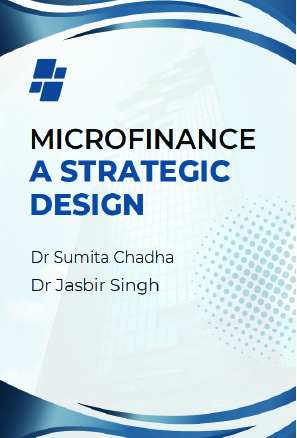
Microfinance: A Strategic Design
Dr. Sumita Chadha and Dr. Jasbir Singh
Format
Paperback and e – book
ISBN
978-81-961857-1-8
Pages
173 Pages
Price
Rs. 1000/- ( $80 )
“MICROFINANCE: A STRATEGIC DESIGN for the bottom of pyramid” Since independence, the priority agenda before the government officials and ministries has been to initiate programs of poverty alleviation and rural development. In this context an important solution to the problem is the provision of rural credit. For combating poverty and to bridge the gap between the demand and supply factors Microfinance emerged as a ray of hope for the most neglected section of society which later on considers to be bottom of pyramid by many corporate and marketing gurus. Microcredit as the name suggests means extending small loans to poor people and that too without any collateral. It has evolved as a powerful mechanism to deliver financial services particularly credit to the section of the community that has been excluded from the services of the main stream institutions. Gradually the concept which has started as Microcredit in most of the developing nations has mushroomed as an umbrella of Microfinance, which not only includes the provision of loan but also the financial services such as savings, remittances, provision of risk mitigation products like insurance and providing financial counselling etc. The success of the Microfinance can be seen worldwide as United Nation declared the year 2005 as the international year of credit and also the success of many Microfinance models like Grameen Bank in Bangladesh and Bank Rakyat in Indonesia etc. According to a 1998 publication by Paul B McGuire, John D Conroy and Ganesh B Thapa, 2.5 crore poor households in India require Rs. 15,000 cores over nine years ending 2005. In another study, the demand for credit was found to be Rs. 9,000 per annum per household among the urban poor. The Paradigm Group survey concluded that average credit availed by each household was approximately Rs. 10,071 per annum in urban India. The source of more than 93.5 % of credit is from the informal sector, where interest rates are often very high. The formal banking sector provides only 0.8 % of the total credit. It is quite ironic that the people who require financial help the most are the ones who have little access to banking services. Later on SHG Self help groups emerge which is a part of empowering the weaker section especially women. The book focuses on how the Micro Finance models can be a strategic design for empowering the bottom of pyramid section of society and how can now corporate can see their fortune lying in the rural sector in comparison to urban sector.

Dr. Sumita Chadha, is an eminent scholar in the field of Finance and Commerce. She is currently working in the capacity of Assistant Professor in Maharaja Surajmal Institute, Delhi under the affiliation of Guru Gobind Singh Indraprastha University. Regarding her academic accolades she is MBA (Finance & Marketing) from Guru Gobind Singh Indraprastha University, M. Phil in Micro Finance from department of Business Economics, Delhi University, B. Com (Hons) from Delhi University.UGC/NET Qualified and all these degrees in the first division throughout.
She has got more 16 years of teaching experience in IP University. She has published more than 30 research papers in various national and international journals. She has presented more than 14 research papers in various national and international conferences. She has got the international experience of volunteering in Victoria Australia also.
Dr. Jasbir Singh, is a eminent scholar in the field of Economics and Money & Banking. He (Associate Prof. (Dy Director) in Maharaja Surajmal Institute under IP university) is M.A Economics (specialization in Money and Banking), M. A Rural Development, MBA in IBM, M Phil in Eco. Ph D in Eco (in Banking), from M. D. University, UGC/NET qualified and 22 years teaching experience in MDU as well IP university. He has published more than 80 research papers in national and international journals. He has presented more than 30 research papers in various national and international conferences.
He has attended more than 40 national and international seminar and conferences as like IIT Roorkee. He is Editor in- Chief of the African Journal on Economic and Development Polices (AJEDP) and Member of Editorial Board in Journal: International Invention Journal of Arts and Social Sciences (IIJASS), and in Journal: Comprehensive Research Journal of Management and Business Studies (CRJMBS). More than 13 students have completed their M. Phil and more than 8 students their Ph. D under his supervision. Seven books have published.